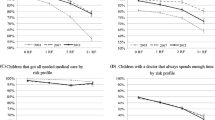Abstract
Objective Children with special health care needs (CSHCN) benefit from a medical home, however, a subset, those children with high intensity needs, have medical and social service issues beyond the capacity of most primary care practices. We describe a novel medical home center that is designed to meet the needs of children with special health care needs of high intensity (CSHCN-HI). Model of care The medical home center, U Special Kids (USK) is located at the University of Minnesota and affiliated with a tertiary medical center. USK serves CSHCN-HI throughout the state of Minnesota and, because of state supported funding for the program, children have access to the program regardless of their health insurance coverage. The team is expert at gathering an overall perspective of the child’s needs, identifying gaps, accessing services and weaving together the plethora of disparate services, agencies and providers. A major goal of this model is to transition care from USK to a primary care medical home within the child’s community. Transition is more likely to occur optimally once the child’s complex needs are organized, the family is trained, adequate management resources are in place, and the intensity of care coordination needs are reduced. Conclusions We propose that, in addition to a primary care medical home, CSHCN-HI benefit from a unique medical home center that can provide sufficient resources and expertise to organize their complex care coordination needs. Medical home centers, designed specifically to manage the care of children with complex high intensity medical and care coordination needs, have the potential to reduce excess health care utilization and improve patient outcomes by providing this group of children with customized, accessible and integrated services.


Similar content being viewed by others
References
Newacheck, P. W., Inkelas, M., & Kim, S. E. (2004). Health services use and health care expenditures for children with disabilities. Pediatrics, 114(1), 79–85.
Antonelli, R. C., & Antonelli, D. M. (2004). Providing a medical home: The cost of care coordination services in a community-based, general pediatric practice. Pediatrics, 113(5 Suppl), 1522–1528.
Palfrey, J. S., Sofis, L. A., Davidson, E. J., Liu, J., Freeman, L., & Ganz, M. L. (2004). The pediatric alliance for coordinated care: Evaluation of a medical home model. Pediatrics., 113(5 Suppl), 1507–1516.
McPherson, M., Arango, P., Fox, H., et al. (1998). A new definition of children with special health care needs. Pediatrics, 102(1 Pt 1), 137–140.
American Academy of Pediatrics Committee on Children with Disabilities. (2005). Care coordination in the medical home: Integrating health and related systems of care for children with special health care needs. Pediatrics, 116(5), 1238–1244.
Kelly, A., Call, K., Staub, B., Donald, B., Wisner, C., Nelson, A., & Blum, R. (2002). Children with complex chronic medical conditions and special needs privately insured through an HMO. Families, Systems and Health, 20(3), 279–289.
Strickland, B., McPherson, M., Weissman, G., van Dyck, P., Huang, Z. J., & Newacheck, P. (2004). Access to the medical home: Results of the National Survey of Children with Special Health Care Needs. Pediatrics, 113(5 Suppl), 1485–1492.
Bethell, C. D., Read, D., & Brockwood, K. (2004). Using existing population-based data sets to measure the American Academy of Pediatrics definition of medical home for all children and children with special health care needs. Pediatrics, 113(5 Suppl), 1529–1537.
Cooley, W. C. (2004). Redefining primary pediatric care for children with special health care needs: The primary care medical home. Current Opinion in Pediatrics, 16(6), 689–692.
Gupta, V. B., O’Connor, K. G., & Quezada-Gomez, C. (2004). Care coordination services in pediatric practices. Pediatrics, 113(5 Suppl), 1517–1521.
Ireys, H. T., Anderson, G. F., Shaffer, T. J., & Neff, J. M. (1997). Expenditures for care of children with chronic illnesses enrolled in the Washington State Medicaid program, fiscal year 1993. Pediatrics, 100(2 Pt 1), 197–204.
Nyman, R, & Ireys, H. (2004). Children with special health care needs: Building a quality-of-care initiative. Mathematic Policy Research, Inc., and the Center for Health Care Policy and Evaluation at United Health Group for the federal Maternal and Child Health Bureau in the U.S., Department of Health and Human Services.
Kelly, A. (2006). Presentation to the Minnesota State Legislature, House and Senate Committees on Health and Human Services. U Special Kids: Intensive case management for children with complex medical problems.
Criscione, T., Walsh, K. K., & Kastner, T. A. (1995). An evaluation of care coordination in controlling inpatient hospital utilization of people with developmental disabilities. Mental Retardation, 33(6), 364–373.
Liptak, G. S., Burns, C. M., Davidson, P. W., & McAnarney, E. R. (1998). Effects of providing comprehensive ambulatory services to children with chronic conditions. Archives of Pediatrics and Adolescent Medicine, 152(10), 1003–1008.
Berman, S., Rannie, M., Moore, L., Elias, E., Dryer, L. J., & Jones Jr., M. D. (2005). Utilization and costs for children who have special health care needs and are enrolled in a hospital-based comprehensive primary care clinic. Pediatrics, 115(6), e637–e642.
American Academy of Pediatrics Medical Home Initiatives for Children with Special Health Care Needs Project Advisory Committee. (2002). Policy Statement: The medical home. Pediatrics, 110(1 Pt 1), 184–186.
US Department of Health and Human Services Health Resources and Services Administration. (1999). Measuring Success for Healthy People 2010: National Agenda for Children With Special Health Care Needs, Rockville, MD.
Stille, C. J., & Antonelli, R. C. (2004). Coordination of care for children with special health care needs. Current Opinion in Pediatrics, 16(6), 700–705.
Acknowledgements
Thank you to Nancy Hoogenhous, RN, Barbara Peterson, MS, CPNP and April Schnell, M.Ed. for help with editing. This work was supported by the Faculty Development in Primary Care General Pediatrics grant, University of Minnesota (grant D55HP04186-03, HRSA, Bureau of Health Professions, DHHS).
Author information
Authors and Affiliations
Corresponding author
Rights and permissions
About this article
Cite this article
Kelly, A., Golnik, A. & Cady, R. A Medical Home Center: Specializing in the Care of Children with Special Health Care Needs of High Intensity. Matern Child Health J 12, 633–640 (2008). https://doi.org/10.1007/s10995-007-0271-7
Received:
Accepted:
Published:
Issue Date:
DOI: https://doi.org/10.1007/s10995-007-0271-7




